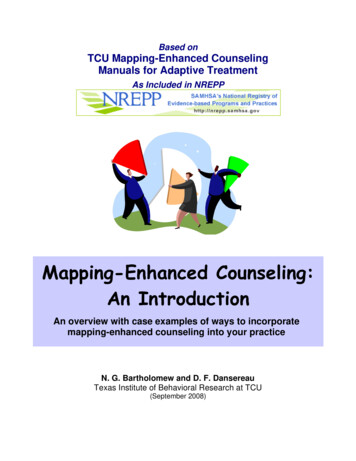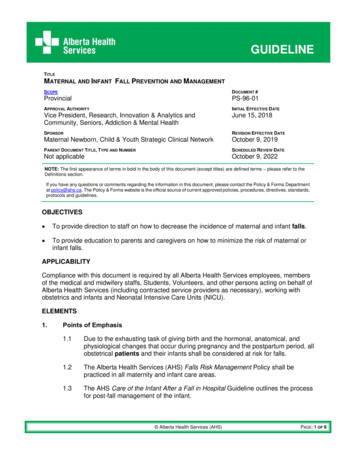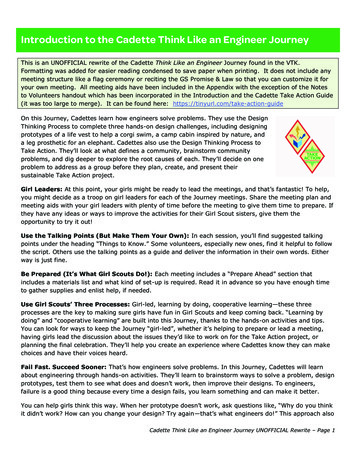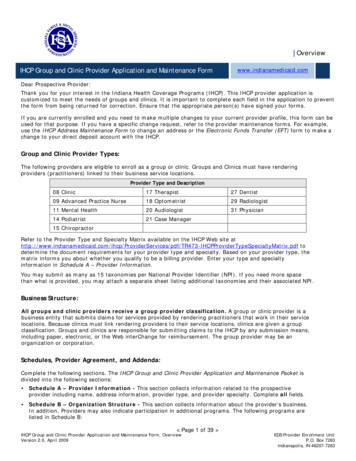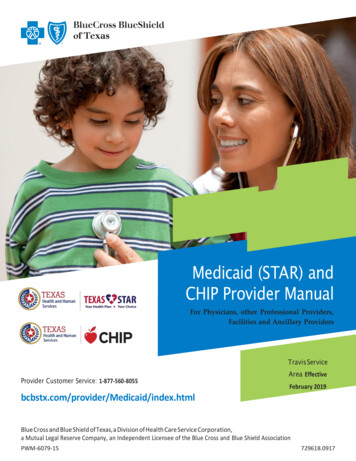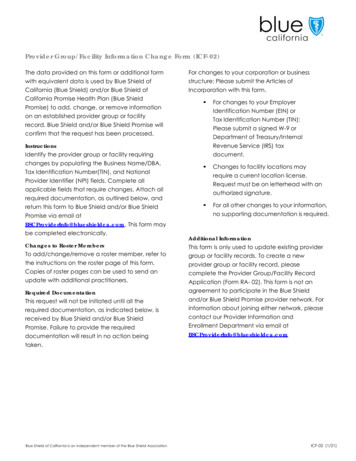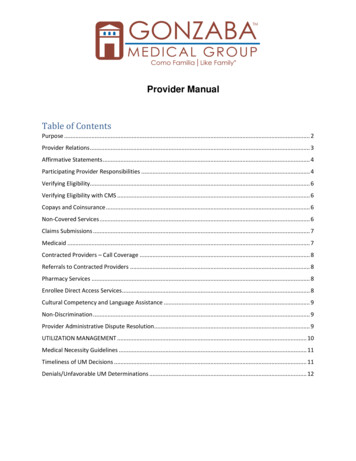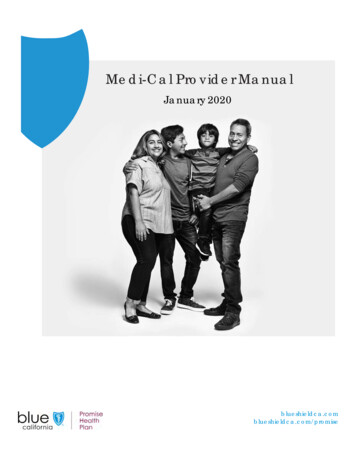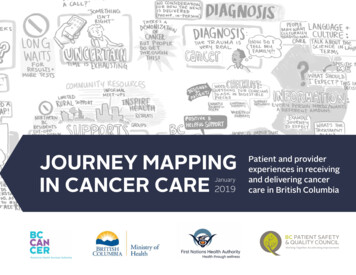
Transcription
JOURNEY MAPPINGIN CANCER CARE 2019JanuaryPatient and providerexperiences in receivingand delivering cancercare in British ColumbiaBC PATIENT SAFETY& QUALITY COUNCILWorking Together. Accelerating Improvement.
This report is in memory of one of the patients who participated in the journeymapping session. Despite being very ill, the patient partner wanted their story tobe heard and known. They passed away eight days after the mapping session.In honour of them, we hope that this report helps to inform and create systemchange for patients, patients’ families and providers.
Table of ContentsBCPSQC.ca02Executive Summary03Purpose03Scope04The Value of Patient Journey Mapping05Journey Mapping Sessions’ Participants06Understanding the Journey Maps10Themes from the Journey Maps35Next Steps35References36Appendices1
Executive SummaryCancer is the leading cause of death in Canada1and, with cancer rates rising, the health caresystem is under continual pressure to providehigh-quality care to rising numbers of patients.Significant advances in research have allowedmany patients to enter remission and livelonger. To support patients and their familiesin receiving whole-person cancer care, thesystem requires a deep understanding of whatmatters to patients in their care and how thecurrent system is experienced by patients.In fall 2018, three journey mapping sessionswith adult patients, families and health careproviders were led by the BC Patient Safety& Quality Council (the Council), in partnershipwith BC Cancer and First Nations HealthAuthority (FNHA). The goals of the sessionswere to inform whole-person cancer carethroughout the entire care experience andimprove transitions for patients receivingcancer treatment in British Columbia.2Each journey map reflects participants’ steps,actions, thoughts and considerations, feelingsand emotions, worries and concerns. Thespecific language used by the participants wasretained whenever possible and direct quotesare incorporated throughout both the reportand the maps. Change ideas generated frompatients and providers are listed alongsideeach theme in the report.The knowledge and information captured inthis report provides an opportunity for policymakers, health care providers and patients tobe inspired and take action towards creatinga better, more person- and family-centredcancer care system.The following themes emerged from the threemapping sessions: Both patients and providers are frustratedby the inconsistency and/or lack ofcommunication as patients move through thesystem The current system is not operating in ashared care model, which leaves it up topatients to coordinate their care Cultural safety and humility is critical to thewellness of Indigenous patients Social and emotional support is integral (notjust nice to have) to supporting patients andtheir families through cancer Patients in rural settings have trouble gettingtreatment close to home Patients desire a whole-person approach tocare A sense of trust is often missing in thepatient-provider relationship There is value in creating environmentsor networks for patients and providers toconnect and collaborate to innovate andimprove the systemBCPSQC.ca
PurposeScopeIn summer 2018, the Council received arequest from the Ministry of Health (MoH)to help inform whole-person cancer careand improve transitions for persons receivingcancer treatment in British Columbia. Inpartnership with BC Cancer and the FirstNations Health Authority (FNHA), threejourney mapping sessions were held inOctober and November to gather informationfrom patients, family members and providers.This report summarizes their findings.The scope of the mapping included the journeyfrom before diagnosis through consultationsin primary care (the General Practitioner (GP)or Nurse Practitioner (NP) typically); diagnosis;first oncologist appointment; supportivecancer care while under the care of BC Cancer,the regional health authority or services in FirstNations communities; and transitions back toprimary usedon Supports for patients to make informedchoices about their cancer care that alignswith their preferences and wishes; Broader assessments for surgical oncologypatients; Enhanced whole-person care for patientsreceiving cancer care; and Smoother transitions back to primary carewhich could include end-of-life or palliativeservices.3
The Value of Patient Journey MappingPatient journey mapping is an effective way to explore and capture the emotional, mental andsocial experiences of individuals and groups interacting with a complex system.2 The process hasbeen successfully used by health systems around the world to engage the patient voice and assistwith health care redesign initiatives.3, 4The mapping is collaborative and asks participants to describe a personal experience as a seriesof interrelated steps that are captured visually on a common drawing space. Unlike simple processmapping, which focuses on capturing steps in a workflow process, journey mapping also focuseson the mindsets, beliefs and emotions that mark each step. This approach highlights experiencesaround delivering and receiving care that are deeply personal and detailed, while allowing forcommon themes to emerge in an easy-to-understand and engaging graphic illustration.In addition to highlighting opportunities for improvement or change, journey mapping can identifythe reasons or drivers behind why patients, family members and health care providers respondas they do along the care journey and in transitions in care. The mapping sessions provide theopportunity for them to engage in a structured and safe environment focused on problemdiscovery and the mutual exploration of improvement opportunities.Journey maps are snapshots in time that explore the mindsets, emotions and experiences ofthe participants that show up on the day, not comprehensive illustrations of the current state ofthe health care system. Readers of the maps can consider them critically and reflect on what isincluded as well as what is missing.4BCPSQC.ca
Journey Mapping Sessions’ ParticipantsNon-Indigenous patient and family partnerswere recruited through the BC CancerPatient and Family Experience Network, whileIndigenous patient and family partners wererecruited through FNHA. A total of 10 patientand family partners, including one Indigenouspatient partner, attended the October session,with an additional 10 Indigenous patientand family partners attending a subsequentmapping session in November.Patient and family partners had experienceswith various types of cancers. Someparticipants had been cancer-free for severalyears; others lived with active tumours butwere not actively in treatment and somewere in active treatment for a current cancer.Participants represented a mix of rural andurban experiences and came from acrossBritish Columbia. For Indigenous patient andfamily partners, participants identified as FirstNations (living at home and away from home)and Cree-Métis.PATIENT October 12, 2018AND FAMILY 10 Patient and familyPARTNER partnersSESSION3 Organizationalrepresentatives fromBC CancerINDIGENOUSPATIENTAND FAMILYPARTNERSESSIONNovember 20, 201810 Patient and familypartners3 Organizationalrepresentatives fromBC Cancer and FNHAPROVIDER October 30, 2018SESSION 3 Allied healthTwo observers from BC Cancer took part inthe first patient and family partner session,while one observer from BC Cancer and onefrom FNHA took part in the Indigenous patientand family partner session. Their roles were tolisten to the participants’ experiences and askclarifying questions as needed. A counsellorfrom BC Cancer was present at both sessionsto offer support to participants.For the provider session, BC Cancer played thelead role in recruiting providers. A total of 13providers attended the session and includednurses from FNHA, allied health staff, GPs(urban and rural), NPs, oncologists, surgeonsand organizational representatives from BCCancer.professionals8 Physicians/NursePractitioners/Nurses2 Organizationalrepresentatives fromBC CancerBCPSQC.ca5
Understanding the Journey MapsThree journey maps were created in the mappingsessions. This section provides context to help thereader interpret the maps. Specific change ideas andthemes that emerged from the sessions are discussedin detail in the next section of the report.For further details regarding how the mappingunfolded and key considerations when interpretingthe maps, please see Appendices A, B and C.High-resolution versions of the maps can bedownloaded from BCPSQC.ca.6BCPSQC.ca
Patient and Family Partner Map – October 2018This map was created in a facilitated discussionwhere we asked patient partners to walk usthrough their cancer care journeys from prediagnosis, through diagnosis to treatment andinto the next chapter after treatment wascompleted. Participants provided rich detailregarding not only the medical aspects of theirjourneys but also their mindsets and feelingsBCPSQC.caassociated with various aspects of the carethey received.The patients’ experiences were combinedinto a single, visual representation of theirexperiences. The patients’ journey is depictedby a yellow “path” highlighting the differentphases of cancer care.Overarching insights that emerged from thediscussion are listed on the left in blue. Alegend, written at the top, identifies pointsalong the patients’ journey where there isa gap in services (red), a potential solution(blue), a key referral (green) or a significantbarrier (purple) exists.7
Indigenous Patient and Family Partner Map – November 2018This map was created by asking patientpartners to walk us through their cancer carejourneys from pre-diagnosis, through diagnosisto treatment and into the next chapter.Participants provided detailed descriptionsregarding their medical journeys as well as8insight into traditional approaches to wellnessand traditional medicine in relation to cancercare. Participants also shared the emotionaland psychological impacts of the journeyson themselves as well as their families andcommunities.The map’s key phases in the journey aredepicted by a blue “path” through the differentphases of the cancer journey. Overarchinginsights which emerged from the discussionare listed on the left in blue. Gaps in the systemare identified in red.BCPSQC.ca
Health Care Provider Map – October 2018A “swim lane” approach was used to documentthe perspectives of health care providers.Each lane on the map represents a differentprovider’s perspective. The conversationbegan by asking primary care providers (PCPs)BCPSQC.cahow they worked with patients when theyfirst suspected the patient had cancer orfound cancer due to a screening process. Theconversation first explored specifics aroundhow patients were referred to differentproviders and programs, and then exploreddiagnosis, treatment and end-of-life care.Overarching themes and key insights based oninput from the various providers are listed atthe top of the map.9
Themes from the MapsEight themes emerged which were consistent across maps and highlight gaps, barriers andopportunities for improvement within the system.10Theme 1Both patients and providers are frustrated by the inconsistency and/or lack ofcommunication as patients move through the systempg. 11Theme 2The current system is not operating in a shared care model, placing the onuson patients to coordinate their carepg. 15Theme 3Cultural safety and humility is critical to the wellness of Indigenous patientspg. 20Theme 4Social and emotional support is integral (not just nice to have) to supportingpatients and their families through cancerpg. 23Theme 5Patients in rural settings face logistical and financial challenges whenaccessing treatment.pg. 26Theme 6Patients desire a whole-person approach to carepg. 29Theme 7A sense of trust is often missing in the patient-provider relationshippg. 32Theme 8There is value in creating environments or networks for patients and providersto connect and collaborate to improve the systempg. 34BCPSQC.ca
THEME 01“I had a FIT test and physical inNovember and received a letterfrom the Cancer Agency thatmy levels were approximately30 times higher than the upperthreshold value. I went to seemy GP and was told my casewas now under BC Cancer andmy GP has nothing to do withit. Eleven months later I hada colonoscopy. I had a lot ofmental distress.”- Patient PartnerBoth patients and providers are frustrated by the inconsistencyand/or lack of communication as patients move through the systemPatients said they feel anxiety and stresswhen care providers do not communicatewell with each other. Patients were often notgiven a timeline for when they would hearback from various providers (“Don’t phone us,we’ll phone you.”) or how long it would take tocomplete tests and receive results.There were multiple accounts from patientswaiting weeks or months to get a confirmeddiagnosis, which heightened their feelingsof anxiety and not being in control of theircare. Patients were frequently unable to findout where they were in the line-up for testsor results despite multiple efforts to find thisinformation.When patients had questions about sideeffects or treatment plans, some cited littleguidance as to who to connect with aboutthese questions. Many patients wanted tospend time with a nurse to talk about theirconcerns but often there was no nurseavailable in person or by phone.BCPSQC.ca“Open-ended waitingmakes me crazy. Ibecome foul, aggressive.It’s a swirling vortex ofemotional crap. Standingin front of someone,advocating for myself,is the only way I knowhow to. You have to bedemanding, boisterous,almost un-Canadian.”- Patient Partner11
“The oncology team inTerrace was amazing. I amgrateful for them. Theywent above and beyond.” Patient Partner“My doctor referred me to the surgeon.The surgeon asked if I had a biopsy, andI said, ‘No, that’s why they sent me here.’He said, ‘The radiologist does thebiopsy, so you need to ask him. I’m goingto write down on a sheet of paper,you’re going to walk across the hospital,and you’re going to stand in x-ray untilyou get an appointment.’Ten days later, I had the biopsy.”- Patient Partner12Many patients did highlight that once theyhad a confirmed diagnosis, their care movedquickly, particularly at BC Cancer. Patientshad very positive experiences when theirtreatment plan was clearly laid out and wellcommunicated. This positive experience hada lasting impact on subsequent aspects oftheir care.“The Cancer Agency stepped up, workedthrough lunch hours, after hours, to getme in shape before my 35 consecutivedays of radiation and three weeks ofchemo. It was like a conveyor belt, whichis good because that means they knowwhat they are doing.”- Patient PartnerProviders echoed this sentiment, saying that when a patient has experienced a long wait orwhen their diagnosis journey has not gone well, “The patient is so traumatized and that nevergoes away. I spend more of my time with them trying to reassure them and build trust in thesystem.”Providers mentioned that in some of their practices they told patients when they will hear fromtheir clinic and providing this timeline has reduced follow-up phone calls by patients wonderingwhen they will hear back from the system.Patients voiced how they were often given inconsistent information from various providers,there did not seem to be a standard way of receiving care in the system, and there was anoverall lack of care coordination. Providers echoed this sentiment, saying that some physicianslike certain tests to be done in advance of seeing the patient, while others order the tests oncethey see the patient.BCPSQC.ca
Patients also noted that there is no standardway of receiving the diagnosis. Some patientsreceived their diagnosis from their GP in theiroffice, while others received it on the phone orheard it from a specialist.“I got to my friend’s house and I received a call and he (the doctor) said I havecancer. I was at my friend’s house, but what if I was driving on the road when Igot the information? Or on the phone while living alone?”- Patient Partner“I need access todedicated people withrapid access to quickadvice because I havea test result that hasscared me. So, whatare my next steps?”Providers agreed that there should be a morestandardized approach across all physicians/NPs when referring a patient to a specialist,including providing a complete medical historywith the referral. Providers voiced that there isa lack of consideration for how sick someone iswhen expediting their need for further testing.- ProviderSome providers tell patients to go to theemergency department to get diagnosticsdone (“It’s a workaround that everyone isdoing out of necessity.”) because of the waitfor diagnostics. Other providers are able toexpedite a patient’s testing based on personalrelationships they have with specialists.Diagnostics are typically only available five daysa week, which does not help ease the backlog.Patients voiced concerns about why diagnosticBCPSQC.catests were not done seven days a week whenmachines are sitting idle and patients arewaiting. Operating rooms also mostly operateonly five days a week, which limits the numberof cancer surgeries that can be done.GPs noted that as they have lost their hospitalprivileges, they no longer have a personalconnection with the specialists, which GPsthought left them unable to expedite care fora patient. GPs mentioned that they want tobe able to talk to an oncologist to get adviceabout how the referral should proceed whenthey are concerned about a patient. Patientsalso wanted to know what number theyshould be calling when they had questions, asthis information was often missing from theirdischarge or treatment instructions and noone was coordinating their overall care.13
Providers suggested that including oncology aspart of Rapid Access to Consultative Expertise(RACE)i would help PCPs ensure that referralswere being made to the appropriate place.Access to RACE would also ensure thatPCPs offer the latest treatments to patientswhich they may not otherwise be aware ofdue to rapid advances in cancer care. Also,ensuring that GPs were using the Pathwaysiisystem would help them make referrals to theappropriate specialist.CHANGE IDEASCommunicate expected wait times and potential treatment options to patientsat every step of the journey.Create consistent referral processes to ensure all GPs know what tests need tobe completed before seeing a specialist.Create consistency in where, when and by whom patients are given theirdiagnosis.Provide patients with an information guide and outline next steps to help themprocess their diagnosis.Develop a system for care coordination which works with patients as they gothrough the cancer process.Add oncology to RACE.Promote the use of the Pathways system to GPs for making oncology referrals.Provide diagnostic imaging and surgery seven days a week.i RACEis an innovative model of shared care where primary care providers can call one phone number and choose from a selection of specialty services for real-time telephoneadvice. In the model, the telephone call is routed directly to the specialist’s cell phone or pager for “just in time” advice.ii Pathways is a web-based directory that connects family doctors and specialists to streamline referrals. Pathways was developed by the Fraser Northwest Division of FamilyPractice, where it was piloted successfully and found to offer genuine solutions to GP-specialist referral issues. Through a password-protected portal, GPs can see the accurate waittimes for each specialist on the Pathways system. There is work ongoing to enable electronic referrals through Pathways but at this time, it is only possible to see the wait times foreach specialist registered in the system.14BCPSQC.ca
THEME 02“I really think peopleare doing the best theycan with what theyhave. Everyone isn’tcommunicating. I wasexpected to keep thethread of communication,but I didn’t always. I was32 and had a lump. The GPsaid I was young and it wasprobably an ingrown hair.”- Patient PartnerBCPSQC.caThe current system is not operating in a shared care model, placingthe onus on patients to coordinate their care.Throughout the mapping sessions, patientsexpressed frustration and shock at how muchthey would need to advocate for themselvesand coordinate their own care. Patients wereparticularly troubled by the transition betweentheir PCP and specialists, and noted that theyneeded to repeatedly inform their PCPs abouttheir care. Furthermore, there is a gap in thesystem to support patients with providingorganized and consistent care coordination.As one patient said, “I have to take 100%responsibility for my care.” This ties inclosely to the first theme regarding a lack ofcommunication. Providers noted that strongcommunication is needed to determinewhich health care provider is coordinatingthe overall care. This is particularly importantwhen patients are transitioning from onehealth care provider to another. The patient isthe only person at every appointment and isoften expected to carry information betweenproviders.“Unless the oncologistlists the potential impactof the treatments, the GPwon’t know to look forthem.”- Patient Partner15
“A care plan givesthe opportunityfor informationtriggers.”- Patient Partner“A lot of our people don’tcomplain and that scares the hellout of me because they just getshuffled around like nothing.”When patients are discharged from their cancer care team, they often return to the care of aPCP who has not been kept up to date with their care. Patients told stories of their dischargereports not being sent, being sent to the wrong doctor, or signing up for clinical trials becausethey wanted to stay connected to their oncologists. Patients were worried that PCPs would notknow what to look for in their post-treatment if they were not given a proper continuing careplan. Patients advocated that a checklist should be given to PCPs, so they would be aware ofthe treatment that patients had received, and what to look for regarding ongoing care and sideeffects – including long-term side effects which patients may experience many years after theirtreatments.One of the risks of not having centralized care coordination is how, when patients do not advocatefor themselves, or are unable to, they can often be left with many unanswered questions. Dueto historic and current negative encounters with health care professionals, some Indigenouspatients said they do not feel comfortable questioning, or advocating for, their care.iii– Lisa Bourque BearskiniiiPlease note, this patient requested to be identified in this report and signed a consent form to this effect.16BCPSQC.ca
“[BC Cancer] neverimpressed on him the needto meet with his GP. Hedied of heart attack oneyear post cancer surgery.”- ProviderProviders wanted to stress the importance of keeping the PCPs in the circle of care for patientsas they move through the cancer system. Providers said that the cancer system is looking afterthe patient from a cancer perspective, whereas a PCP is still responsible for the rest of their care.Regular screening, immunizations, and check-ups should continue to be done by the PCP.It must be acknowledged that many patients do not have a PCP, which creates a major barrier inbeing able to receive continuing care between a specialist and a PCP. In the Indigenous session,one-third of participants did not have a PCP and others would soon lose theirs as their providerswere close to retirement. As one patient said, “I didn’t have a GP to loop back to after. I’mcompletely alone now.”Patients indicated that the discharge back to primary care felt ‘like jumping off a cliff’ as they wereconcerned there would be no continuity of care from their cancer team to primary care. SomeNPs in the community are trying to fill the gap by providing ongoing follow-up care to patientswith cancer once their acute treatment with the oncologist is complete.BCPSQC.ca17
Providers were resounding in their support of a shared care model for patient care to bettersupport patients. A true team-based approach to care would allow each provider to know theirrole throughout the journey and help to increase trust with patients. Providers mentioned theincreasing frequency of interdisciplinary care conferences for complex cases and the value thatthey provide both the health care team and patients and families. Some patients voiced theneed to have more decision aids available, rather than general cancer information, to help informdecisions about treatment options. A good example of interdisciplinary care came from severalpatients who had excellent relationships with their pharmacists, who worked with the patients’care teams and found ways to cover medications for them when the costs became prohibitive.“I was so impressedby the Indigenouspatient navigator inthe hospital. She wasamazing.”– Lisa Bourque BearskinProviders suggested that having a patient portal available would “revolutionize the patientexperience.” A patient portal would allow patients to see their cancer journey, where they wereat in the stages of treatment as well as their appointments, reports and images. It may also openthe opportunity to explore virtual appointments with providers, thereby reducing the need forpatients to travel to all appointments.18BCPSQC.ca
Patients also raised the idea of having a wayto track where they were in the health caresystem. Just like one can track a package sentin the mail, patients wanted to be able to seewhere their case was in the queue at eachpoint in the journey.The role of a patient navigator (sometimescalled a nurse navigator or system navigator)came up in every mapping session. Someclinics have already implemented the role ofthe patient navigator which ensures that theproper connections and treatment are beingprovided for the patient.In many cases, a navigator has allowed patientsto move through the system faster and, as oneprovider stated, “Nurse navigators are lifechanging.”ivCHANGE IDEASCreate a way for patients to track where they are in the cancer journey system. Patientswant to know that their case is being processed, even if there is going to be a wait time.Ensure every patient and their PCP is given a continuing care plan with triggers forwhat to look for post-treatment.Encourage the widespread adoption of patient navigators in the cancer system.Develop a patient portal for patients to track their appointments, progress andtreatment in the system.Ensure all patients know the importance of continuing to see their PCP for their healthduring their cancer treatment and upon discharge from their cancer team.ivCreate mechanisms to support true shared care models to support patients, includingGPs, NPs, specialists, nursing, and allied health professionals.It is recognized that attachment to a PCP remains an ongoing issue for many patients in BC and there are strategies working on this issue in the province.BCPSQC.ca19
THEME 03“Every time I went tothe room where theydid the radiation,I closed my eyes.Every time I closedthem, I could feel myancestors with meand supporting me.”- Patient PartnerCultural safety and humility is critical to wellness of IndigenouspatientsIndigenous patients and their families notedthat the importance of the role of traditionalwellness and healing in their cancer journeycannot be overstated. Indigenous patientsrepeatedly referenced the support receivedfrom ancestors and families as well as theirbelief in the significance of spiritual practice inhelping stay positive and resilient throughouttreatment.Many patients identified specific practicessuch as sweats, connecting with the land,being brushed with cedar, praying with Elders,taking cold water baths and using traditionalmedicines as practices which were importantin supporting their health and wellness.Patients identified how important it was toinclude their families in their cancer journeysin order to gather strength and positivity tomake it through the treatment. For many,family members were advocates in the system,while others relied on families to ensure theywere given traditional foods known to providestrength.20“We had a family sweat.We prayed at every meal.The prayers really work inhelping to stay positive.”- Patient PartnerBCPSQC.ca
“I ended up not communicatingwith my health care team aboutthe traditional medicine I wastaking. There was a seriousside effect of my silence. Withradiation, I used bear fat to keepmy skin moist, but I was startingto burn. The nurse said, ‘You’renot using cream?’ and I said, ‘No,I’m using bear fat.’Bear fat wasn’t good becauseit was actually intensifying theradiation and I ended up gettinga permanent burn on my lung.”– Lisa Bourque BearskinBCPSQC.caMany patients noted they used traditionalhealing to support their chemotherapy andradiation treatments, and some who did chosenot to disclose it to their health care providers.Patients thought they were typically notsupported by providers in conversations abouttraditional healing and many had experienceswhere they felt judged and, therefore,remained silent.There can be significant risks to patient safetywhen patients feel they must stay silent abouttheir use of traditional healing and medicinewhen also receiving Western treatments.Patients also noted that one cannot justtake traditional medicines like you would aWestern therapy. Traditional medicines mustbe incorporated into a system of beliefs andclosely integrated with spiritual practices inorder to be effective.“The doctors scared me.I had a whole case ofmedicine from my aunties.I used it a few times, butthe doctors said it mightinteract with my (Western)medication so it’s beensitting in my fridge for thepast six months.”- Patient Partner21
Indigenous patients had a variety of experiencesof being supported in their decisions toincorporate trad
The Value of Patient Journey Mapping Patient journey mapping is an effective way to explore and capture the emotional, mental and social experiences of individuals and groups interacting with a complex system. 2 The process has been successfully used by health system
